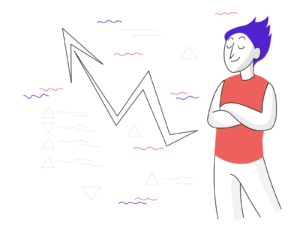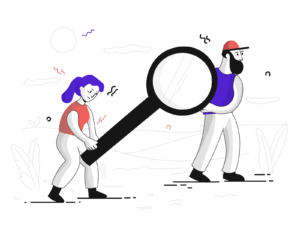A lead means who has potential to become your client. a chance could also be a professional lead—a one that has been deemed likely to undertake to business alongside your company supported their need for your product or service, budget, timeline, etc. an opportunity may be a lively prospect that’s currently being pursued by your sales team to maximize conversions.
What is a Lead?
A lead could also be one that has shown interest in your product or service in how, shape, or form. They’ll have visited your website, subscribed to your newsletter, or called your business after seeing an ad. It is vital to note that a lead isn’t necessarily a paying customer; rather, they’re simply someone who has expressed interest in what you’ve to provide to maximize conversions.
What is a Prospect?
A prospect could also be a possible customer who has shown interest in your product or service. They’ll not be ready to buy yet, but they’re interested by what you’ve to provide. There are several stages to the sales process, and a chance is typically at the beginning or middle stage.
At the beginning stage, a chance could also be learning about their problem and therefore the way it are often solved. They’ll not even know that your product or service exists yet. It’s your job to show them on the matter and therefore the way your solution can help.

Lead
A lead means who has potential to become your client. a chance could also be a professional lead

Opportunity
When it involves business, opportunities are key. An opportunity could also be a possible chance to sell your products or your services to the clients to maximize conversions.
What is an Opportunity?
When it involves business, opportunities are key. An opportunity could also be a possible chance to sell your products or your services to the clients to maximize conversions. This could be a replacement lead that has been generated, or an existing prospect that you simply simply are nurturing.
There are 3 types of opportunities to maximize conversions:
1. New lead:
A replacement lead is someone who has interested in your products or your services, but hasn’t been contacted by your sales team yet.
2. Existing prospect:
An existing prospect is someone who has been contacted by your sales team, but hasn’t converted into a customer yet.
3. Referral:
A referral could also be a contact who has been recommended to your sales team by a current customer or client.
What is the difference between Leads, Prospects and Opportunities?
When it involves lead generation, there’s plenty of confusion around the terms leads, prospects and opportunities. To clear things up, we are going to take the far better inspect the definition of each term and therefore the way they differ from one another.
Leads: A lead may be a private or organization that has shown interest in your product or service in how. This may be through subscribing to your email list, downloading newsletter or attending your webinars.
Prospects: a chance could also be a lead that has been qualified as being an honest suit your product or service. This means they have been contacted and engaged with in how, and have demonstrated an interest in learning more about what you’ve to provide.
Opportunities: an opportunity could also be an opportunity that’s ready to buy your product or service. They already have been through sales process, are just waiting on a final decision from their budget holder, or they could be ready to sign up the road directly.
Lead vs. prospect: to maximize conversions
A lead could also be a possible customer who has shown an interest in your product or service in how, usually by filling up form or signing up the newsletter.
A chance is someone who has been identified as an honest candidate for your product or service, but hasn’t yet been contacted.
An opportunity could also be a prospective buyer who has been contacted and is ready to be sold to. A lead can become a chance once you’ve got more information about them and you’ve decided they’re likely to possess an interest in what you’re doing.
As an example, you’d possibly have their contact details and know that they add your target market.
A prospect can become an opportunity once you create contact with them which they show interest in what you’ve to provide.
In order to drive sales and maximize conversions, it is vital to specialize in each of these stages. You’d wish to get leads and qualify them into prospects, then nurture those prospects into opportunities.
Each stage is critical and needs focused effort so on enable you to satisfy your targets and drive revenue.
Leads are the beginning line, but prospects and opportunities are the more important targets for you to specialize in in your business. It’s much easier to makeover a chance into the opportunity than it is to convert the lead into the opportunity.
Lead vs. opportunity: to maximize conversions
Understanding difference between lead and opportunity. Here some tips help you differentiate between two:
-A lead is who has expressed interest in your product or service, but won’t be ready to buy. An opportunity could also be a possible sale.
-A lead typically needs more nurturing than an opportunity.
-An opportunity is usually further along within the sales cycle than a lead.
-Leads can come from many sources, like marketing campaigns, trade shows, or website visitors. Opportunities usually arise from contact with leads.
-Leads must be converted into opportunities through sales activities like follow-up calls and emails.
-The outcome of a lead and an opportunity are often different. A lead won’t convert into a sale, but an opportunity is more likely to become a sale.
-the key difference between a lead and an opportunity is that while a lead expresses interest in your product or service, an opportunity could also be a possible sale.
– With proper nurturing and sales activities, you’ll turn leads into opportunities and ultimately convert them into sales.
Types of Leads:
There are three kinds of leads in business: prospects, hot leads, and cold leads.
- Prospects are potential customers who are identified as having a requirement for your product or service. They’ll have skilled an ad, visited your website, or requested more information from you.
- Hot leads are prospects that exhibit high buying interest and how of urgency. They’re typically further along within the sales cycle than cold leads and wish immediate attention.
- Cold leads are prospects that don’t yet have any buying interest or sense of urgency. They not aware of their needs for product or service till yet.
- Ultimately, all of these leads need to be nurtured so on convert into paying customers. That’s why it’s important for businesses to continuously cultivate their lead pool so on stay their pipeline full.
- Good lead generation tactics are key to success. That’s why businesses should strive to use a mix of selling, content marketing, and digital ads so on get high-quality leads and maximise conversions.
How to Generate Quality Leads and Prospects?
- The most important a neighbourhood of generating leads is ensuring that they are high quality and maximise conversions.
- First, consider what your ideal customer looks like.
- What characteristics do they have? What details do them must solve? Once you’ve good understanding about it, you’ll start to form content which can speak on to them. These are often in kind of webinars, posts, eBooks, or articles on the online site.
- Another great way to urge high quality leads is through social media. Platforms like LinkedIn offer great opportunities to connect with potential customers and build relationships.
- You’ll also use social media to share your helpful content and drive traffic back to your website.
- Don’t forget about good quaint networking. Attend relevant conferences and events, or host your own meet ups and get-togethers.
- Get out there and meet people face-to-face; it’s still one of the only ways to make trust and generate quality leads.
Tips to maximize Conversions from leads to Opportunities
- Keep your leads organized –
One of the only ways to maximise conversions from leads to opportunities is to remain your leads organized. Having a central place where you’ll view and manage all of your leads will assist you prioritize follow-up and confirm that no lead falls through the cracks.
Scoring your leads can assist you prioritize follow-up and focus your efforts on the foremost promising prospects. Leads are often scored supported factors like demographics, behaviour, and engagement level.
- Nurture your leads –
Nurturing your leads is vital for maximize conversions. By developing relationships with prospects over time, you’ll create a deeper level of trust and connection which can increase the likelihood of conversion when the time is true.
- Convert leads into opportunities –
When a lead is ready to be converted into an opportunity, make sure to document all relevant information in your CRM system so as that the sales team has everything they need to successfully move forward with the sale.
- Define your target market–
Who are you trying to achieve alongside you’re along together with your alongside your product or service? Narrowing in on a specific target market will assist you create simpler messaging that resonates with your audience and drives maximize conversions.
- Craft an irresistible offer–
What are you ready to provide your target market that they cannot resist? Your offer should be something that solves a haul or meets a requirement for your target market.
- Create a strong call-to-action–
Once you’ve defined your target market and made an irresistible offer, confirm your call-to-action is clear and persuasive. Your CTA should tell your prospects what you’d like them to undertake to (e.g., sign up for a free trial, download a white paper, etc.) and why they need to appear the hay (e.g., “gain valuable insights into their business”).
- Design a landing page that converts–
Once you’ve created your offer and call-to-action, it’s time to style a landing page which can persuade your visitors to need action. Confirm your landing page is targeting one specific goal (e.g., conversion), easy to navigate, and includes relevant images and replica.
- Nurture your leads–
Even after you’ve succeeded in converting a lead into an opportunity, the work isn’t over yet! You’d wish to continue nurturing your relationship with this new opportunity
Conclusion
although the terms lead, prospect and opportunities sound quite similar, all of them have very different meanings. A lead could be a private or organization that has shown interest in your product/service.
A chance is someone who has engaged with you and expressed some genuine interest in learning more about your products or services and should even become a possible customer.
And an opportunity is that the likelihood of generating business from these leads and prospects and maximize conversions. But regardless on which type you’re handling, always remember to help them understand the price of what you offer before attempting to upsell.
Reviewed By
-
algorithmchttps://blog.algorithmc.com/author/algorithmc/
-
algorithmchttps://blog.algorithmc.com/author/algorithmc/
-
algorithmchttps://blog.algorithmc.com/author/algorithmc/
-
algorithmchttps://blog.algorithmc.com/author/algorithmc/



